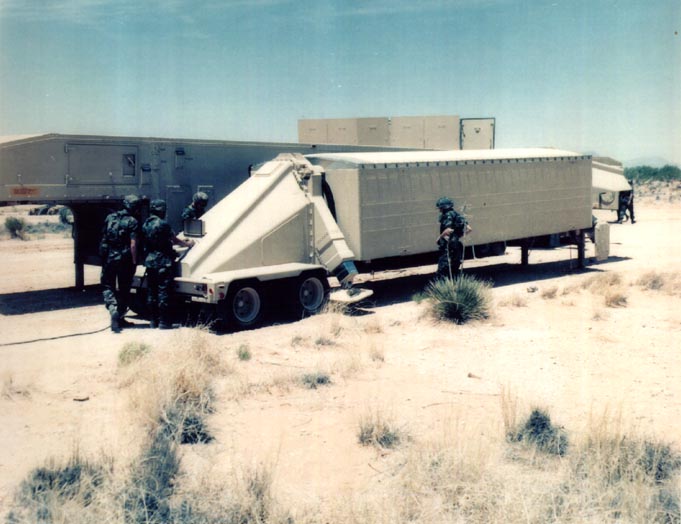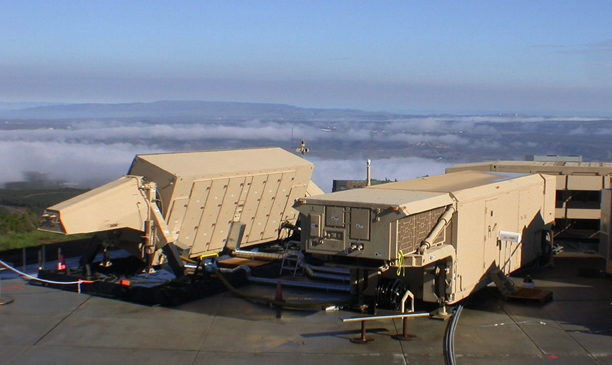TPY-2 (Forward Based X-Band Radar) on:
[Wikipedia]
[Google]
[Amazon]

 The AN/TPY-2 Surveillance Transportable Radar, also called the Forward Based X-Band Transportable (FBX-T) is a long-range, very high-altitude active
The AN/TPY-2 Surveillance Transportable Radar, also called the Forward Based X-Band Transportable (FBX-T) is a long-range, very high-altitude active

 The AN/TPY-2 Surveillance Transportable Radar, also called the Forward Based X-Band Transportable (FBX-T) is a long-range, very high-altitude active
The AN/TPY-2 Surveillance Transportable Radar, also called the Forward Based X-Band Transportable (FBX-T) is a long-range, very high-altitude active digital antenna array
Digital antenna array (DAA) is a smart antenna with multi channels digital beamforming, usually by using fast Fourier transform (FFT).
The development and practical realization of digital antenna arrays theory started in 1962 under the guidance ...
X band surveillance radar designed to add a tier to existing missile and air defence systems. It has a range of . Made by Raytheon
Raytheon Technologies Corporation is an American multinational aerospace and defense conglomerate headquartered in Arlington, Virginia. It is one of the largest aerospace and defense manufacturers in the world by revenue and market capitaliza ...
, it is the primary radar for the Terminal High Altitude Area Defense
Terminal High Altitude Area Defense (THAAD), formerly Theater High Altitude Area Defense, is an American anti-ballistic missile defense system designed to shoot down short-, medium-, and intermediate-range ballistic missiles in their terminal ...
(THAAD) missile system, but also cues the AN/MPQ-53 radar of the MIM-104 Patriot
The MIM-104 Patriot is a surface-to-air missile (SAM) system, the primary of its kind used by the United States Army and several allied states. It is manufactured by the U.S. defense contractor Raytheon and derives its name from the radar compon ...
system. Patriot PAC-3 is a lower-altitude missile and air defense system than THAAD.
The AN/TPY-2 is a missile-defense radar that can detect, classify, track and intercept ballistic missiles. It has two operating modes – one to detect ballistic missiles as they rise, and another that can guide interceptors toward a descending warhead. Once it detects the missile, it acquires it, tracks it, and uses its powerful radar and complex computer algorithms to discriminate between the warhead and non-threats such as countermeasures in order to destroy the missile with a hit to kill kinetic warhead.
The AN/TPY-2 is a digital antenna array
Digital antenna array (DAA) is a smart antenna with multi channels digital beamforming, usually by using fast Fourier transform (FFT).
The development and practical realization of digital antenna arrays theory started in 1962 under the guidance ...
radar
Radar is a detection system that uses radio waves to determine the distance (''ranging''), angle, and radial velocity of objects relative to the site. It can be used to detect aircraft, ships, spacecraft, guided missiles, motor vehicles, w ...
, which operates in the 8.55–10 GHz X band
The X band is the designation for a band of frequencies in the microwave radio region of the electromagnetic spectrum. In some cases, such as in communication engineering, the frequency range of the X band is rather indefinitely set at approxim ...
. Raytheon builds it as part of an X-band family, along with the National Missile Defense (NMD) X-Band Radar (XBR) and AN/FPS-129 HAVE STARE. The use of X band provides better target resolution than lower frequency bands, for example the L band
The L band is the Institute of Electrical and Electronics Engineers (IEEE) designation for the range of frequencies in the radio spectrum from 1 to 2 gigahertz (GHz). This is at the top end of the ultra high frequency (UHF) band, at the lower en ...
, though lower frequency bands generally have better performance in detecting low RCS targets. The X band frequency and narrow beam width improve differentiation, or “range resolution,” between smaller objects, such as between warheads, clutter, and decoys. Once the information about the threat of missile is received, determining information such as its speed and trajectory, this data is immediately passed along to (BMDS) tracking, discrimination, and fire control radars downstream. This approach provides extending sensor coverage, the possibility to extend the BMDS battlespace, and the ability to complicate missiles ability to penetrate the defense system.
The U.S. Missile Defense Agency (MDA) and Raytheon plan to improve detection range and sensitivity of the X-band TPY-2 missile defense radar through the introduction of gallium nitride semiconductor components.
Deployment
TheU.S. Army
The United States Army (USA) is the land service branch of the United States Armed Forces. It is one of the eight U.S. uniformed services, and is designated as the Army of the United States in the U.S. Constitution.Article II, section 2, cl ...
developed the system and remains responsible for its use by air defense artillery
The Air Defense Artillery Branch is the branch of the United States Army that specializes in anti-aircraft weapons (such as surface to air missiles). In the U.S. Army, these groups are composed of mainly air defense systems such as the Patrio ...
in theater and tactical applications. As a component of national ballistic missile defense, the U.S. Missile Defense Agency
The Missile Defense Agency (MDA) is the section of the United States government's Department of Defense responsible for developing a layered defense against ballistic missiles. It had its origins in the Strategic Defense Initiative (SDI) which ...
is responsible for AN/TPY-2 applications.
It has been deployed in Japan to collect strategic-level information on North Korean missile developments, as well as warning Japan of incoming warheads. Also, AN/TPY-2 radar in Shariki region is able to scan Russian territory near Japan. Japan has bought both PAC-3 for point defense, and is upgrading the AEGIS systems on its Kongo-class destroyers so they can use the longer-range RIM-161 Standard Missile 3
The RIM-161 Standard Missile 3 (SM-3) is a ship-based surface-to-air missile system used by the United States Navy to intercept short- and intermediate-range ballistic missiles as a part of Aegis Ballistic Missile Defense System. Although primari ...
theater ballistic missile defence.
An AN/TPY-2 is based in Alaska as part of United States national missile defense
National missile defense (NMD) is a generic term for a type of missile defense intended to shield an entire country against incoming missiles, such as intercontinental ballistic missile (ICBMs) or other ballistic missiles.
This is also used ...
development. The U.S. has agreed to provide it to Israel, to complement their two-tier Arrow 2 missile and Patriot PAC-3 missile defense.
It complements the fixed AN/FPS-129 HAVE STARE X-Band "large dish" radar, located at Vandenberg Air Force Base. Smaller mobile X-band dishes, not yet designated, may also be paired with the AN/TPY-2.
References
{{CCBYSASource, sourcepath=http://en.citizendium.org/wiki/TPY-2, sourcearticle=TPY-2, revision=767211227 Anti-aircraft warfare Radar units of the United States Air Force